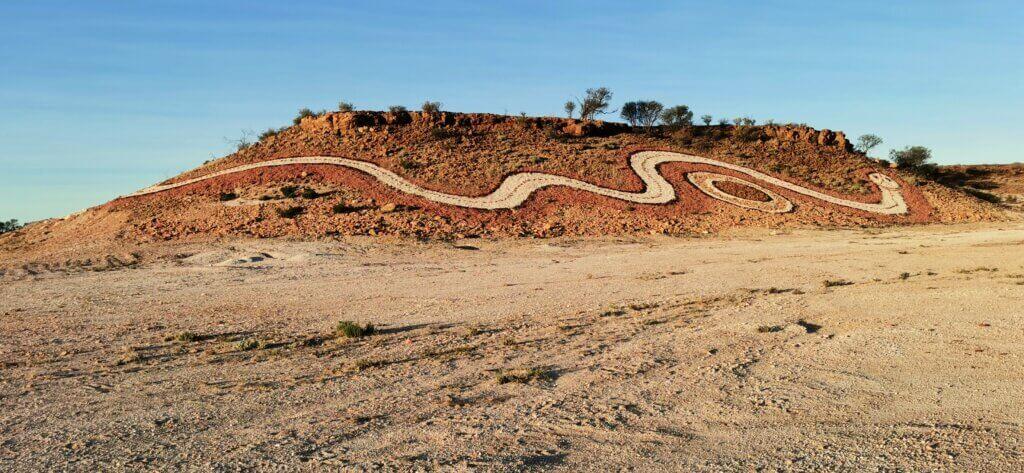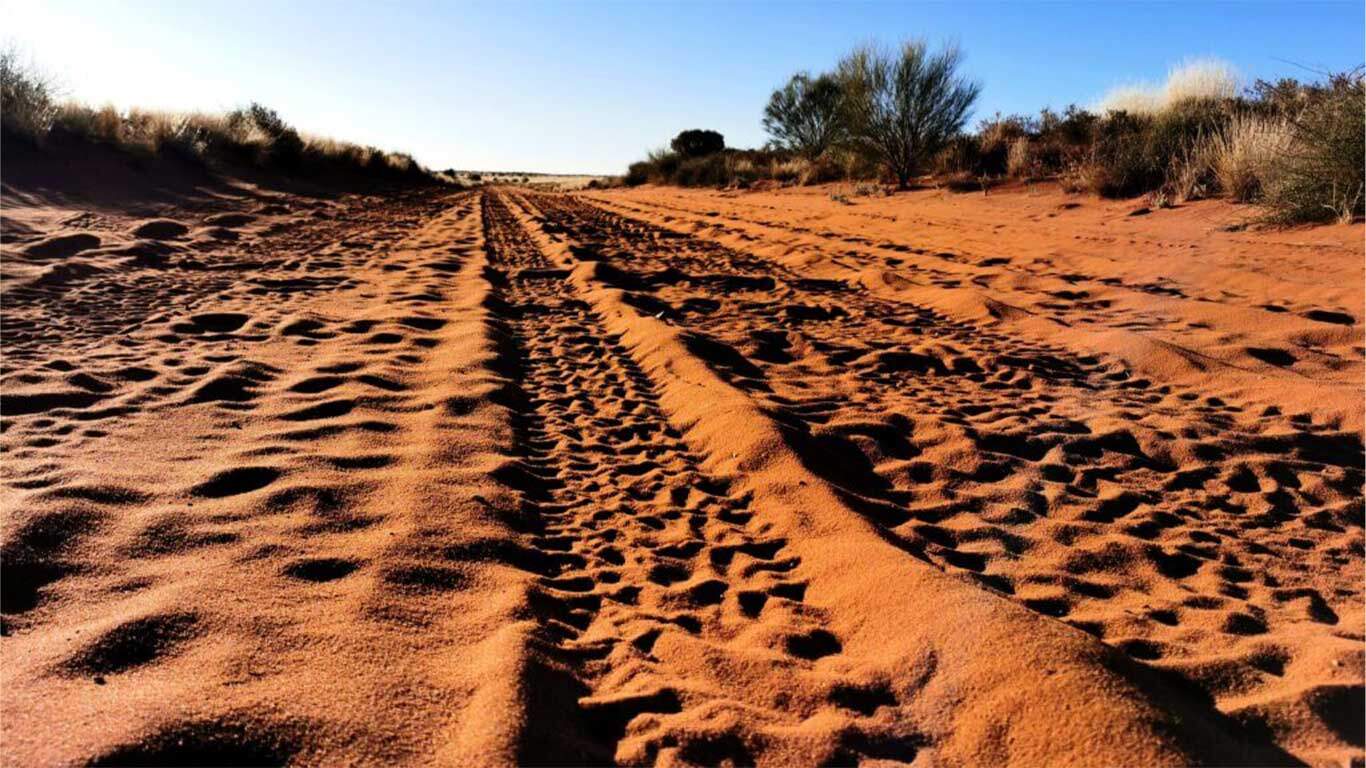Dates – 14th-19th June | Distance – 519km | Total distance – 859km
DAY 4 | INNAMINCKA TO THE DIG TREE | 58KM
On reaching Innamincka, the first thing we needed to find out was whether I could cycle to Birdsville from there. The planned route along the Cordillo Road was closed due to flooding and Walker’s Crossing, the shortest route, had also been closed for a few seasons. Fortunately, the publican of the Innamincka Hotel was able to confirm that the only other option, the Arrabury Road had just re-opened, otherwise we would have had no way of reaching Birdsville.

Having pushed myself to reach Innamincka (142km) the day before, I decided to take it easy in the morning, and just aim to reach the Dig Tree, some 58km along the Adventure Way, a sealed road.

The Dig Tree, 14km via Nappa Merrie Station, is the site that represents both the achievement and tragedy of the 1860-61 Burke and Wills expedition. It was here, at Camp 65, that Burke, Wills, King and Gray set off on their main push to make the first European crossing of the continent to reach the Gulf of Carpentaria. Burke left a small group of men, lead by Brahe, at Camp 65, the site of the Dig Tree, Burke telling them to wait three months for them to make the return journey. Wills apparently said to wait for four months.

Brahe waited for over four months, desperately clinging to the hope that Burke and Wills would return. Finally Brahe and his team left on 21st April 1861, sure that Burke’s party had all perished. That evening, only 9 hours later, Burke, Wills and King arrived at the abandoned Dig Tree Camp; Gray had died on the return journey from the Gulf. A carving on the tree read DIG and the basic supplies Brahe buried there sustained the men with some food provided by local Aboriginals. The men were too weak to try to follow Brahe’s party. In desperation they tried to cross the Strzelecki Desert but when their camels died, they returned to Cooper Creek. Starving and exhausted, Wills and then Burke died and only King survived because he was cared for by local Aboriginal people. He was rescued two and a half months later.

Taking in the history at the actual site I found very moving but also haunting, thinking of how desperate the men must have been. The expedition was poorly planned and executed from the start, born out of grand Victorian-era colonial vision, the choices (personnel and logistics) they made were not suitable to cope with the environment they were to travel through – in summer!

DAY 5 | ARRABURY ROAD | 90KM
From the Dig Tree I headed north on Arrabury Road – my favourite road so far, full of character. After about 15km I entered the St Ann Range, as series of mesas and buttes, with minerals eroding from the flat-topped hills. Spectacular. The hills gave way to sand dune country. The road that tracked parallel to the line of dunes, was sandy at times but mostly hard-packed clay base beneath the sand, and I made pretty good time cycling over it.

DAY 6 | ARRABURY ROAD | 111.2KM
About 15km from our campsite, I passed the Arrabury Station turnoff and the road connecting to the Cordillo Downs Road. I had hoped to take this shortcut to the Burke Development Road but unfortunately it was still closed. I had no choice but to continue all the way to the end of Arrabury Road, a route adding a further 70km to my journey! At least there was a way through!
Here the route crossed the eastern fringe of the Sturt Stoney Desert. The stark landscape was like a sea of gibber (stones) with the only trees being those that lined the occasional creek. At 45km, I stopped at the ruins of what was probably an old outstation. The wooden posts had stood defiant for possibly a century of harsh, weathering climate and white ants. The nearby Arabie Creek would have been the water supply for the stock, most likely sheep judging by the size of the remaining fence posts. I can’t imagine what the stock lived off, and how harsh the existence would have been for those pioneering settlers. This was winter, so summer out here would be extreme.


Continuing north, I could see the occasional distant range, and at times, sand dunes almost encroached over the road.
DAY 7 | 100KM
I had high hopes of taking a short cut as shown on OzExplorer, which would have cut 30km off my route, but the tracks had been closed since the maps were last reproduced. Since the rains, the landscape was becoming greener and small flowers were starting to bloom. It was wonderful to see this area in such good heart.


After 35km, I finally reached the end of the Arrabury Road and turned west onto the Birdsville Development Road. My legs were really starting to get very heavy and were aching constantly. This was a much longer first stint on the road than I had intended and I just had to find a way to keep the pedals turning.
Despite feeling worse for wear, we decided to divert off the main road to Betoota, famously the world’s smallest town. The lone hotel has an interesting history, first used as an interstate customs post in 1885. Then after a police presence was established, in 1915 the building became a prison before it became a hotel complete with dance floor in 1923. Having run into decline, it was taken on by a new owner and reopened in 2020, amidst the Covid-19 pandemic. I met with the seasonal manager, Julie Eaton and her husband and got to learn more about the place.



DAY 8 | 111KM
By now I was just focusing on keeping an even effort. The Birdsville Development Road was generally in good condition – good gravel most of the way with occasional strips of tarmac over the steeper sand dunes, along floodways and emergency airstrips. I was also dealing with a headwind at times streaming up from the southwest. The second half of the day the road started to follow the course of the mighty Diamantina River, a major artery of the Channel Country. There was a lot of water in the clay pans between the dunes. I willed myself to within 50km of Birdsville and we enjoyed another delightful bush camp; stunning sunset and sunrise, a cold, starry night and a crackling campfire.

DAY 9 | 49KM
Although the final push into Birdsville was only going to be half a day, it seemed to last forever. Some of the vistas were so green, I could have been in the tropics!


Finally I reached the famous Birdsville Racecourse and 4km later I had cycled over the Diamantina River and into town.













